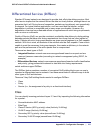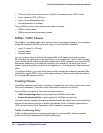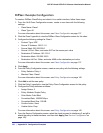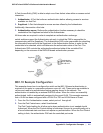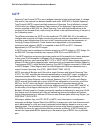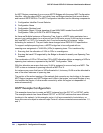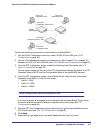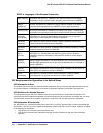
Appendix B: Configuration Examples | 263
GS716Tv2 and GS724Tv3 Software Administration Manual
MSTP
Spanning Tree Protocol (STP) runs on bridged networks to help eliminate loops. If a bridge
loop occurs, the network can become flooded with traffic. IEEE 802.1s Multiple Spanning
Tree Protocol (MSTP) supports multiple instances of Spanning Tree to efficiently channel
VLAN traffic over different interfaces. Each instance of the Spanning Tree behaves in the
manner specified in IEEE 802.1w, Rapid Spanning Tree, with slight modifications in the
working but not the end effect (chief among the effects is the rapid transitioning of the port to
the Forwarding state).
The difference between the RSTP and the traditional STP (IEEE 802.1D) is the ability to
configure and recognize full duplex connectivity and ports that are connected to end stations,
resulting in rapid transitioning of the port to the Forwarding state and the suppression of
Topology Change Notification. These features are represented by the parameters
pointtopoint and edgeport. MSTP is compatible to both RSTP and STP. It behaves
appropriately to STP and RSTP bridges.
A MSTP bridge can be configured to behave entirely as a RSTP bridge or a STP bridge. So,
an IEEE 802.1s bridge inherently also supports IEEE 802.1w and IEEE 802.1D.
The MSTP algorithm and protocol provides simple and full connectivity for frames assigned
to any given VLAN throughout a Bridged LAN comprising arbitrarily interconnected
networking devices, each operating MSTP, STP or RSTP. MSTP allows frames assigned to
different VLANs to follow separate paths, each based on an independent Multiple Spanning
Tree Instance (MSTI), within Multiple Spanning Tree (MST) Regions composed of LANs and
or MSTP Bridges. These Regions and the other Bridges and LANs are connected into a
single Common Spanning Tree (CST). [IEEE DRAFT P802.1s/D13]
MSTP connects all Bridges and LANs with a single Common and Internal Spanning Tree
(CIST). The CIST supports the automatic determination of each MST region, choosing its
maximum possible extent. The connectivity calculated for the CIST provides the CST for
interconnecting these Regions, and an Internal Spanning Tree (IST) within each Region.
MSTP ensures that frames with a given VLAN ID are assigned to one and only one of the
MSTIs or the IST within the Region, that the assignment is consistent among all the
networking devices in the Region and that the stable connectivity of each MSTI and IST at
the boundary of the Region matches that of the CST. The stable active topology of the
Bridged LAN with respect to frames consistently classified as belonging to any given VLAN
thus simply and fully connects all LANs and networking devices throughout the network,
though frames belonging to different VLANs can take different paths within any Region, per
IEEE DRAFT P802.1s/D13.
All bridges, whether they use STP, RSTP or MSTP, send information in configuration
messages via Bridge Protocol Data Units (BPDUs) to assign port roles that determine each
port’s participation in a fully and simply connected active topology based on one or more
spanning trees. The information communicated is known as the spanning tree priority vector.
The BPDU structure for each of these different protocols is different. A MSTP bridge will
transmit the appropriate BPDU depending on the received type of BPDU from a particular
port.



